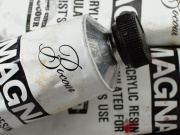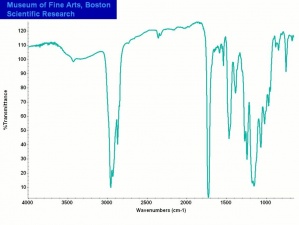Difference between revisions of "Magna Plastic Colors"
(username removed) |
|||
| (8 intermediate revisions by 4 users not shown) | |||
| Line 2: | Line 2: | ||
== Description == | == Description == | ||
| − | [Bocour Artists' Colors] A brand name for a series of acrylic paints prepared from pigments dispersed in n-butyl methacrylate resins and diluted with [ | + | [Bocour Artists' Colors] A brand name for a series of acrylic paints prepared from pigments dispersed in n-butyl methacrylate resins and diluted with [[turpentine%20%28oil%29|turpentine]], [[mineral%20spirits|mineral spirits]], [[xylenes|xylenes]], and [[toluene|toluene]]. The paints dry rapidly to a hard, matte, nonyellowing film. Released in 1947, Magna colors were the first commercially available synthetic resin paints. In the 1950s, the formulation was changed to include small amounts of [[beeswax|beeswax]] for added paint body (Lodge 1988). Several famous painters, including Morris Louis, Kenneth Noland, and Roy Lichtenstien, were known to have used these paints (Learner 2004). Bocour discontinued Magna Colors in the mid-1970s (Crook and Learner 2000). A similar formulation, called [[Golden%20MSA%20Conservation%20Paints|MSA Conservation Paints]], is made by Golden Artist Colors. |
| − | + | [[[SliderGallery rightalign|mMagna paint IR.jpg~FTIR]]] | |
| − | [[ | ||
== Synonyms and Related Terms == | == Synonyms and Related Terms == | ||
Magna Colors [Bocour] | Magna Colors [Bocour] | ||
| − | == | + | == Physical and Chemical Properties == |
| − | Paints are dilutable with turpentine, mineral spirits. | + | * Paints are dilutable with turpentine, mineral spirits. |
| + | * Dry films dissolve in xylenes, mineral spirits and turpentine. | ||
| + | * Tg = about 22 C | ||
| − | + | ==Resources and Citations== | |
| − | + | * Jo Crook, Tom Learner, ''Modern Paints'', Tate Gallery Publishing, London, 2000, p. 25-27. | |
| − | |||
| − | |||
| − | |||
| − | |||
| − | + | * Thomas J.S. Learner, ''Analysis of Modern Paints'', Getty Conservation Institute, Los Angeles, 2004 Comment: "1947 .. paint maker Leonard Bocour introduced the first line of artists' acrylic paints, Magna" | |
| − | + | * R. G. Lodge, A History of Synthetic Painting Media with Special Reference to Commercial Products, AIC Preprints, 16th Annual meeting, 1988 Comment: sold in 1949 | |
| − | + | * Tom Learner, A review of Synthetic Binding Media in Twentieth-Century Paints., ''The Conservator'', Vol. 24, 2000 | |
| − | |||
| − | * | ||
* ''The Dictionary of Art'', Grove's Dictionaries Inc., New York, 1996 Comment: "Acrylic" gives date of first use as 1946 | * ''The Dictionary of Art'', Grove's Dictionaries Inc., New York, 1996 Comment: "Acrylic" gives date of first use as 1946 | ||
| − | * | + | * Marie Svoboda, Conservation Survey Index, unpublished, 1997 |
| − | |||
| − | |||
| − | |||
| − | |||
| − | |||
| − | |||
[[Category:Materials database]] | [[Category:Materials database]] | ||
Latest revision as of 12:14, 16 October 2022
Description
[Bocour Artists' Colors] A brand name for a series of acrylic paints prepared from pigments dispersed in n-butyl methacrylate resins and diluted with turpentine, Mineral spirits, Xylenes, and Toluene. The paints dry rapidly to a hard, matte, nonyellowing film. Released in 1947, Magna colors were the first commercially available synthetic resin paints. In the 1950s, the formulation was changed to include small amounts of Beeswax for added paint body (Lodge 1988). Several famous painters, including Morris Louis, Kenneth Noland, and Roy Lichtenstien, were known to have used these paints (Learner 2004). Bocour discontinued Magna Colors in the mid-1970s (Crook and Learner 2000). A similar formulation, called MSA Conservation Paints, is made by Golden Artist Colors.
Synonyms and Related Terms
Magna Colors [Bocour]
Physical and Chemical Properties
- Paints are dilutable with turpentine, mineral spirits.
- Dry films dissolve in xylenes, mineral spirits and turpentine.
- Tg = about 22 C
Resources and Citations
- Jo Crook, Tom Learner, Modern Paints, Tate Gallery Publishing, London, 2000, p. 25-27.
- Thomas J.S. Learner, Analysis of Modern Paints, Getty Conservation Institute, Los Angeles, 2004 Comment: "1947 .. paint maker Leonard Bocour introduced the first line of artists' acrylic paints, Magna"
- R. G. Lodge, A History of Synthetic Painting Media with Special Reference to Commercial Products, AIC Preprints, 16th Annual meeting, 1988 Comment: sold in 1949
- Tom Learner, A review of Synthetic Binding Media in Twentieth-Century Paints., The Conservator, Vol. 24, 2000
- The Dictionary of Art, Grove's Dictionaries Inc., New York, 1996 Comment: "Acrylic" gives date of first use as 1946
- Marie Svoboda, Conservation Survey Index, unpublished, 1997

